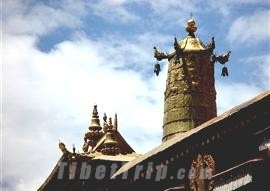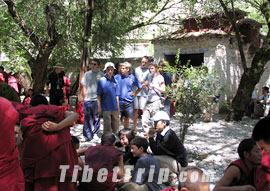 Sera Monastery, one of the Three Great Monasteries of Gelugpa, stands at the foot of Sera Utse Mountain, in the northern suburb of Lhasa. There are two traditions as to why the monastery was named Sera. One is that a fierce hailstorm occurred when the monastery was founded; the other is that a large tract of wild roses bloomed where the monastery now stands. Since both the words 'hail' and 'wild roses' are 'sera' in Tibetan, the monastery was named Sera.
Sera Monastery, one of the Three Great Monasteries of Gelugpa, stands at the foot of Sera Utse Mountain, in the northern suburb of Lhasa. There are two traditions as to why the monastery was named Sera. One is that a fierce hailstorm occurred when the monastery was founded; the other is that a large tract of wild roses bloomed where the monastery now stands. Since both the words 'hail' and 'wild roses' are 'sera' in Tibetan, the monastery was named Sera. In 1414, one of Tsong Khapa's disciples, Sakya Yeshe, on behalf of Tsong Khapa, had an audience with the Emperor Chengzhu of the Ming Dynasty (1368 - 1644). The Emperor granted him the title of Dharma King of Great Mercy and also granted him an imperial mandate together with sutras, Buddhist statues and objects, gold, silver, silks and satins. In 1419, in order to house these Buddhist treasures, Sakya Yeshe built the Sera Monastery, which now includes Coqen Hall, the main assembly hall; three Zhacangs (Buddhist colleges) and twenty-nine Khangtsens or monk dormitores. The monastery covers an area of over 110, 000 square meters (27 acres).









